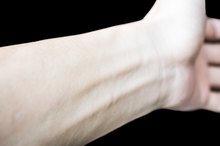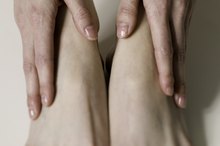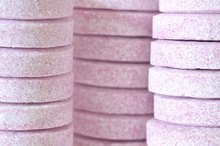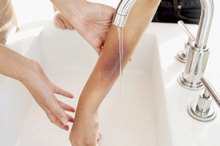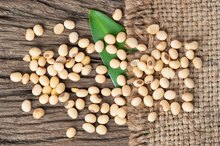What does fact checked mean?
At Healthfully, we strive to deliver objective content that is accurate and up-to-date. Our team periodically reviews articles in order to ensure content quality. The sources cited below consist of evidence from peer-reviewed journals, prominent medical organizations, academic associations, and government data.
The information contained on this site is for informational purposes only, and should not be used as a substitute for the advice of a professional health care provider. Please check with the appropriate physician regarding health questions and concerns. Although we strive to deliver accurate and up-to-date information, no guarantee to that effect is made.
Splits in Fingers Due to Vitamin C Deficiency
Vitamin C is essential for the health of your skin. If you develop a vitamin C deficiency, you may experience cracked or splitting skin on your fingers and other areas. It is rare for someone in the United States to develop this deficiency, but if you think you aren't getting enough vitamin C, consult your physician.
Signs of Deficiency
There are several signs of a vitamin C deficiency. These include splits in your skin, and it may also become rough, dry or scaly. Additionally, you may experience dry hair with split ends, inflamed and bleeding gums, nosebleeds, a compromised immune system, anemia, swollen joints and weakened tooth enamel. If you become severely deficient in vitamin C, you can develop scurvy, a condition characterized by these same symptoms. You may also notice bruise-like spots on the skin around your hair follicles if you develop scurvy.
- There are several signs of a vitamin C deficiency.
- You may also notice bruise-like spots on the skin around your hair follicles if you develop scurvy.
Risks
Folic Acid & Gray Hair
Learn More
Older adults who become malnourished are at the greatest risk for developing a vitamin C deficiency and its accompanying symptoms. However, smokers also have an increased risk, as smoking lowers the amount of vitamin C in your body. If you are an alcoholic or follow a restrictive or fad diet, you may be at risk for a deficiency as well. People who have malabsorption diseases or who are on dialysis may become deficient, too.
- Older adults who become malnourished are at the greatest risk for developing a vitamin C deficiency and its accompanying symptoms.
- If you are an alcoholic or follow a restrictive or fad diet, you may be at risk for a deficiency as well.
Treatment
The treatment for scurvy is typically vitamin C supplements, and the dosage and frequency will vary according to the severity of your condition. Typically, your doctor will have you take 800 to 1,000 mg of vitamin C a day for one week or more, followed by 400 mg a day until you have recovered entirely, according to DermNet NZ 3. Once you begin the treatment, your symptoms, including the splitting skin, should begin to subside within 24 hours. In the meantime, talk to your doctor about applying a hypoallergenic lotion or cream to moisturize your skin and promote healing.
- The treatment for scurvy is typically vitamin C supplements, and the dosage and frequency will vary according to the severity of your condition.
- Typically, your doctor will have you take 800 to 1,000 mg of vitamin C a day for one week or more, followed by 400 mg a day until you have recovered entirely, according to DermNet NZ 3.
Prevention and Additional Considerations
Signs & Symptoms of Mild Anemia
Learn More
Prevent a vitamin C deficiency and its symptoms by consuming a diet rich in fruits and vegetables. Oranges, green peppers, watermelon, papaya, grapefruit, strawberries, winter squash, cauliflower and potatoes are all excellent sources of this vitamin. Adult males need 90 mg of vitamin C a day, and adult women need 75 mg. If you do not meet the RDA through diet, ask your doctor about adding a supplement to make sure that you do not develop a deficiency. Also let her know about the skin problems you are having and ask about any creams or lotions that may help.
- Prevent a vitamin C deficiency and its symptoms by consuming a diet rich in fruits and vegetables.
- If you do not meet the RDA through diet, ask your doctor about adding a supplement to make sure that you do not develop a deficiency.
Related Articles
References
- MedlinePlus; Vitamin C; February 2011
- University of Maryland Medical Center; Vitamin C (Ascorbic Acid); June 2009
- DermNet NZ; Scurvy; June 2011
- Callus CA, Vella S, Ferry P. Scurvy is Back. Nutr Metab Insights. 2018;11:1178638818809097. doi:10.1177/1178638818809097
- National Center for Advancing Translational Sciences. Scurvy. Updated November 14, 2016.
- Bouaziz W, Rebai MA, Rekik MA, Krid N, Ellouz Z, Keskes H. Scurvy: When it is a Forgotten Illness the Surgery Makes the Diagnosis. Open Orthop J. 2017;11:1314-1320. doi:10.2174/1874325001711011314
- Brambilla A, Pizza C, Lasagni D, Lachina L, Resti M, Trapani S. Pediatric Scurvy: When Contemporary Eating Habits Bring Back the Past. Front Pediatr. 2018;6:126. doi:10.3389/fped.2018.00126
- Khalife R, Grieco A, Khamisa K, Tinmouh A, Mccudden C, Saidenberg E. Scurvy, an old story in a new time: The hematologist's experience. Blood Cells Mol Dis. 2019;76:40-44. doi:10.1016/j.bcmd.2019.01.004
- Wijkmans RAA, Talsma K. Modern scurvy. J Surg Case Rep. 2016;2016(1):rjv168. doi:10.1093/jscr/rjv168
- Hansen EPK, Metzsche C, Henningsend E, Toft P. Severe Scurvy After Gastric Bypass Surgery and a Poor Postoperative Diet. J Clin Med Res. 2012;4(2):135-37. doi:10.4021/jocmr726w
- Perry ME, Page N, Manthey DE, Zavitz JM. Scurvy: Dietary Discretion in a Developed Country. Clin Pract Cases Emerg Med. 2018;2(2):147-150. doi:10.5811/cpcem.2018.1.36860
- National Institutes of Health, Office of Dietary Supplements. Vitamin C Fact Sheet for Health Professionals. Updated February 27, 2020.
- Institute of Medicine (US) Panel on Dietary Antioxidants and Related Compounds. Dietary Reference Intakes for Vitamin C, Vitamin E, Selenium, and Carotenoids. Washington, DC: The National Academies Press; 2000.
Writer Bio
Lynne Sheldon has over 12 years of dance experience, both in studios and performance groups. She is an avid runner and has studied several types of yoga. Sheldon now works as a freelance writer, editor and book reviewer. She holds a Bachelor of Arts in English and art history from Boston University and recently completed her Master of Fine Arts in writing from Pacific University.


